
Note: In my efforts to include all the useful tips for event bloggers I could think of, before I knew it this post came to over 2400 words! Please consider bookmarking this post as a resource you can refer to whenever you're stumped for ways to get your event blog going. Also, please consider following us on twitter and our Meeting and Event Tips facebook page for more useful info as it comes. Enjoy! --Kenji
If you're promoting an event or conference, chances are you've heard that having a website and blog can be a great way to drive awareness and (hopefully) registrations. There are plenty of great guides out there on SEO, social media and blogging. The question is: where do you start?
The answer is simple: Start with your strengths. If you're blogging to promote an event, you have advantages over other bloggers that are not only easy to leverage, but can jump start your traffic and drive event sign-ups.
Advantage #1: Video Content from Speakers
Before you get carried away with social media strategies or SEO techniques know this: 80% of a blog's success is dependent on its content. If you're running an event blog, chances are that you'll have access to videos of speakers giving talks at past events, and what can be better than exclusive video content from experts? Posting these videos on your blog can be an excellent way to build traffic and links back to your website. When you do, ensure that you consider these tactics:
Self-Host Your Video Content
While it's certainly easy to host your videos on YouTube or Vimeo and then embed them directly on your site, you may want to consider hosting your videos on your own site.
Why do this? Well, let's say you're running a blog for an annual wombat trainer's conference. You have an excellent video by a world renowned zookeeper on the proper diet for wombats. If you upload this video to YouTube and then embed the video on your blog, Google will determine that the original source of the video was YouTube and will thus rank youtube.com higher than your site in the Search Results for the keyword: "Wombat Diet Video." This shouldn't be the case.
If you expect a lot of people to be searching for videos on wombat nutrition, then it would behoove you to host the video on your own site. One great tool for doing this is Wistia, a platform that allows you to host your videos on your own domain. Not only does it do that, but it provides transcription services so that you can post the full transcript of the talk or presentation directly to your blog. Search engines are smart, but they're still not smart enough to determine just how relevant to wombats your video really is. The text transcripts below the video can be a great way to help the nudge search engines in the right direction.
Wistia's starter package runs for $23 a month so it isn't cheap. If you plan to have a lot of event related video content on your site, however, I highly recommend checking them out.
Optimize Your Video for the Web
When filming, camera operators and video editors don't always take into account the fact that their videos will be seen on laptops and mobile devices. Although wide angle shots can be good to establish the size of a venue, remember that on an iPhone screen the speaker will probably be less than 10 pixels high. Make sure the camera stays in close to a speaker.
Save Your Best Content for VIPs
While you might be tempted to publish all your video content on your blog, it's important to ask yourself one question: Are you converting? Are you adding more subscribers to your newsletters or getting more people to sign up for your event?
If you're getting thousands of visitors to your site and the answer is "no," you may want to think of ways you can limit access to premium content as a way to drive more conversions. Think about reserving your best content for a select group of people like your newsletter subscribers, members of your organization, or people who have signed up for your upcoming event. It's actually quite easy to do this. Wordpress, for example allows you to specify whether links are public, private or even password protected so that you can effectively control who is able to see what content.
Finally, if all you want is to get more traffic, consider using a service like Pay with a Tweet. Pay with a tweet is a very simple service that limits access of content to those who have tweeted about it, thus driving traffic and awareness.
Advantage #2: Guest Posts From Speakers
You may not be an authority on wombats, but the speakers attending your wombat conference probably are. Be sure to leverage that authority by asking your speakers to write guest posts for your blog.
Rel=Author
If you have a lot of famous wombat experts contributing guest posts, you may want to consider using the rel = author markup on your blog. Let's say that George Georgeson is the world's foremost expert on wombats. George happens to be speaking at your conference and not only that he has agreed to write a guest post on your event's blog. The post title is "How to Train a Baby Wombat" which, in this hypothetical situation, also happens to be a high traffic keyword.
Since your blog is new and doesn't have many links, your post about training baby wombats may not rank very high for such a competitive keyword. Because of this, your post probably wouldn't get too many clickthroughs. But since you've been savvy enough to implement rel=author on your page, what do you know...George Georgeson's face appears next to your article on the search engine results page.
It would look something like this:

Any wombat enthusiast would be able to recognize George's face right away and would most likely click the article written by him before the others, even though they might be ranked higher. Implementing rel=author on a blog requires having a page on your blog with a list of contributors as well as requiring each of your contributors to have a Google+ account. For more detailed instructions on how to implement rel=author, please check out this resource.
Advantage #3: Your event/conference is already well known
Listen for your event name or brand
It's quite possible that your conference is already well known by folks who happen to be influential online. It's important that you find out who these influencers are, and what they're saying about you. My favorite tools to keep track of online conversations are:
SocialMention: SocialMention is a great tool to keep track of who's saying what about your brand. If you enter "West Coast Wombat Conference" into the search box, for example, the tool will return nearly all tweets and blog posts and some facebook posts that mention the conference. I check SocialMention for eVenues at least once a day so that I can follow up on anything said about us, either positive or negative.
Topsy: Topsy is one of the most accurate ways to track tweets about a blog post you've recently published. To track the tweets all you have to do is type http://topsy.com/www.yourdomain.com/your-blog-post-url and you'll have a handy, up to date look of how your blog post is doing. Here's an example of how one of our recent blog posts did on Topsy
Google Alerts: Although you'll usually be able to monitor most mentions of your brand using the above two tools, Google alerts can be a good way to be notified of new blog posts that mention your brand, especially if you don't have time to check social listening tools every day. Just go to Google Alerts, and type in any keywords relevant to your brand and you'll be notified of any new blog posts about your event.
Listening, of course, isn't just a one way street. It's important to respond immediately to any mention, whether it's positive or negative. It's amazing how many brands and companies fail to do this. If someone says something good about your wombat conference, thank them and perhaps provide them with a discount code for the ticket (Eventbrite allows you to set this up pretty easily).
If, on the other hand, someone tweets something negative about your conference, it's also important to address this just as quickly. See if you can get in touch with whoever tweeted about you and see if you can resolve the issue by moving it over to a private email conversation.
Finally, if someone writes a blog post endorsing your event, go further than just sending them a quick "thank you" email. Make sure you get the best links possible too.
Most likely a blogger will link to your website with the official name of the event or conference, something like "West Coast Wombat Conference 2012" While this is an OK link, it could be much better. After all, the keyphrase mentioned above is so specific that you'll probably rank #1 for that phrase on Google without any links. Not only that, but the only people who would use that keyphrase in their searches would know about your conference to begin with.
It'd be much better if you got a link to your home page with something more generic like "Wombat Conference." Links like these are signals to the search engines that your blog and website is relevant for that keyword. The more links like this that you get, the higher you'll rank in searches for people looking for wombat conferences, but don't necessarily know about your wombat conference. Since these bloggers are already endorsing your event with a link, it shouldn't be a problem to get the wording of the link to be changed slightly.
Use Social Bookmarking Sites to Promote Your Content
While it would be nice to just create great content and expect people to visit your website, that sadly isn't the case. You need your content to be shared and tweeted by as many people as possible--not only because it brings more exposure to your event blog, but also because tweets and shares are becoming an increasingly important signal of quality to search engines like Google.
It's quite possible that your wombat conference is already well known among wombat enthusiasts. But even if 2012 is the very first year of your conference and no one has heard of it before, that doesn't mean that the online wombat community won't want to help you out to promote your great content, if indeed it truly is great.
The first place to go when looking for the right influencers to share your content is followerwonk. Followerwonk is a twitter bio search engine that finds the most influential twitter accounts in a certain field. If, for example, you want to reach out to wombat trainers on the west coast, do a keyword search for "wombat trainer" on followerwonk and limit your search to major cities like Los Angeles, San Francisco, Seattle and Portland. Once you've found these people, engage with them. Follow them on twitter, comment on their blogs and tweet and share their content.
Utilize Online Communities
Building a respectable network on Twitter, however, can take some time. Even though you may have tried to reach out to these "Twitterati," they may be too busy to even notice you. This is where online communities and forums come in.
One of my favorite places to share content is reddit. Reddit is a social news sharing site that has over 2 billion (!) visits per month. People post links to their favorite content, and depending on how many votes that content receives, it has a chance to get featured on the front page, potentially driving hundreds of thousands of visitors to your site.
The trick to reddit is to find the appropriate subreddit that represents a group who would be interested in your content. Subreddits are basically what they sound like: mini-versions of reddit focused on a single topic. There are subreddits for cities like Seattle, Los Angeles, New York and Chicago, as well as subreddits for music, architecture, cats, and believe it or not, wombats.
Subreddits can be a very powerful way to deliver content to the right audience. An article I had written about secret spots in Seattle, for example, reached the #1 spot on the Seattle subreddit and sent thousands of visitors to the eVenues blog. It was at least a good third of the Seattle subreddit's 12,000 subscribers.
It's very possible, however, that the subreddit which covers your conference's topic won't have many subscribers. At this writing, there are only 7 subscribers to the wombat subreddit. This doesn't mean, however, that you can't post your content on a subreddit that focuses on a tangentially related topic. George Georgeson's article on how to train a baby wombat, for example, could probably do well on a subreddit like pets.
Along with reddit, there are other major social bookmarking sites like Digg, StumbleUpon and Pinterest. Each of these sites serve very different content and different audiences, and it's important to know what's appropriate for each. A guide on choosing wedding dresses, for example would probably do better on Pinterest because the audience is mostly women. Funny list posts, on the other hand, might do much better on Digg or StumbleUpon.
Furthermore, there are many niche social bookmarking sites that might better serve your audience. Hacker News, for example, is almost exclusively focused on programming, entrepreneurship and startups. BizSugar, on the other hand, is better suited for those running small businesses. DesignBump is almost exclusively for designers while Tip'd is focused mostly on finance topics. Know which sites give you the best ROI in terms of traffic and conversions and do your best to develop your presence in each space.
Finally, it's important not to post content that is solely self-promotional. Be sure that your content is useful, interesting or entertaining and is a match for your audience. Also, don't post content until you've "lived" in those online communities for a while and get a feel for what succeeds with each one. When you do, you'll be able to tailor your content precisely for those communities. If you do all that, you're bound to succeed.
What about you? What advice do you have for event bloggers on leveraging their advantages?
-----
P.S. If you have yet to book a venue do check our listings out. We have a great list of Seattle meeting spaces as well as spaces in San Francisco and Los Angeles.
If you have any questions about this guide please feel free to email me at kenji [at] evenues dot com.
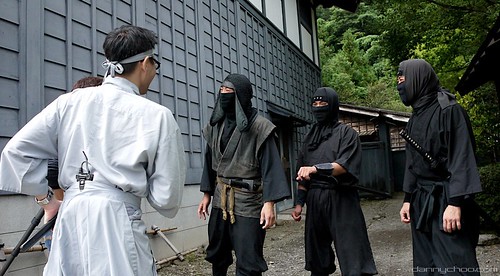
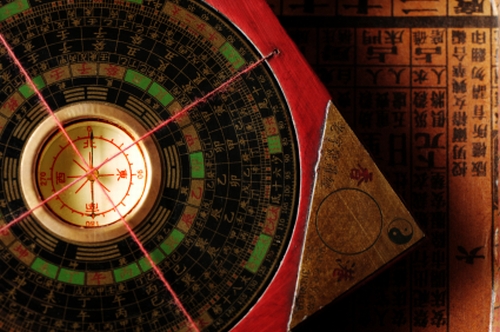
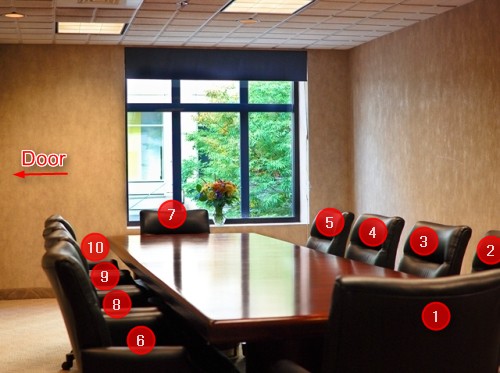

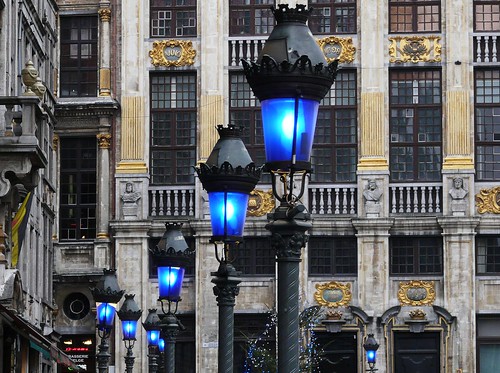


 At
At 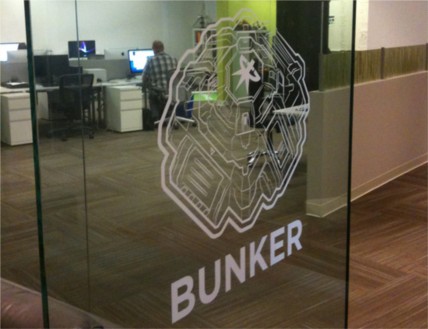
 Room names:Â Batcave, Hall of Justice, Thunderdome, Death Star, Mos Eisley Cantina, Spider Skull Island.
BackStory:Â SEOMoz is a company that creates SEO Software. True to the "fun" tenet of their
Room names:Â Batcave, Hall of Justice, Thunderdome, Death Star, Mos Eisley Cantina, Spider Skull Island.
BackStory:Â SEOMoz is a company that creates SEO Software. True to the "fun" tenet of their 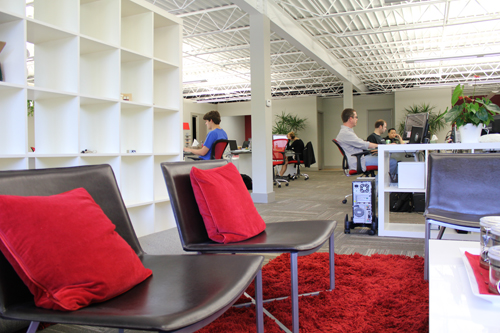 Room Names:Â Endeavor(Pictured Above), Armstrong, Gemini, Mercury, Discovery, Atlantis, Voyager, Lovell, Glenn
Bathroom Names:Â George, Jane, Judy, and Elroy :D
Backstory:Â Red Nova Labs is a web development and marketing agency. The company got its name from a red nova, a stellar explosion thought to be caused by the merger of two stars. Thus it seemed only natural for the rooms around the building have been named after space explorers, scientists and vehicles. Not only do the room names reflect the company name, but the red and white company colors are ubiquitous throughout the space.
You can see more pictures of the space
Room Names:Â Endeavor(Pictured Above), Armstrong, Gemini, Mercury, Discovery, Atlantis, Voyager, Lovell, Glenn
Bathroom Names:Â George, Jane, Judy, and Elroy :D
Backstory:Â Red Nova Labs is a web development and marketing agency. The company got its name from a red nova, a stellar explosion thought to be caused by the merger of two stars. Thus it seemed only natural for the rooms around the building have been named after space explorers, scientists and vehicles. Not only do the room names reflect the company name, but the red and white company colors are ubiquitous throughout the space.
You can see more pictures of the space 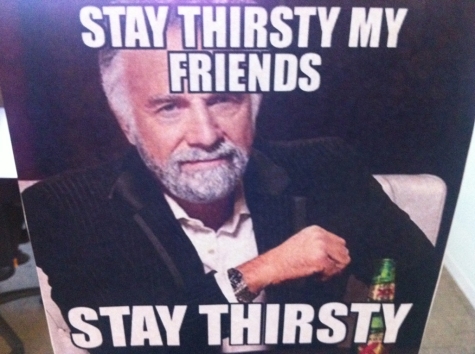 Room Names:Â "It's 5:00 Somewhere" and "Stay Thirsty My Friend"
Backstory:Â Poggled is a company that focuses on nightlife and deals on bar tabs. Extra points for the "most interesting man" poster in the "Stay Thirsty" room :).
Room Names:Â "It's 5:00 Somewhere" and "Stay Thirsty My Friend"
Backstory:Â Poggled is a company that focuses on nightlife and deals on bar tabs. Extra points for the "most interesting man" poster in the "Stay Thirsty" room :).